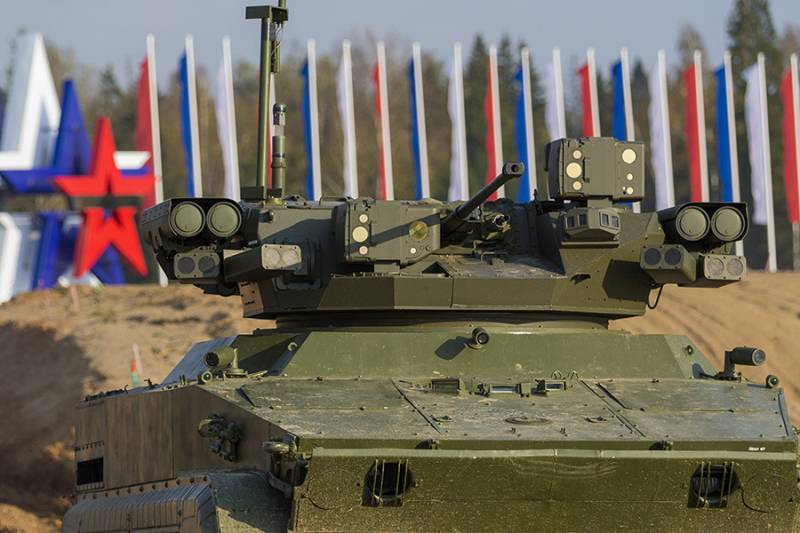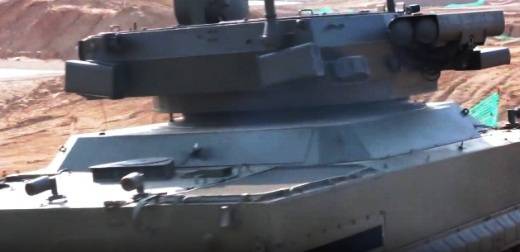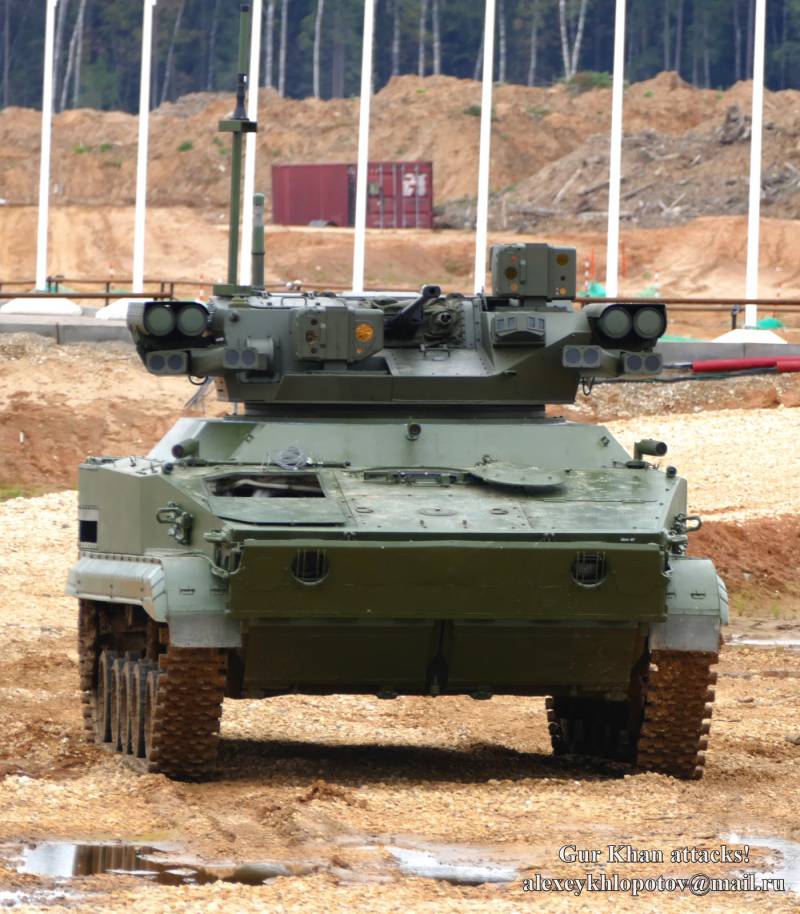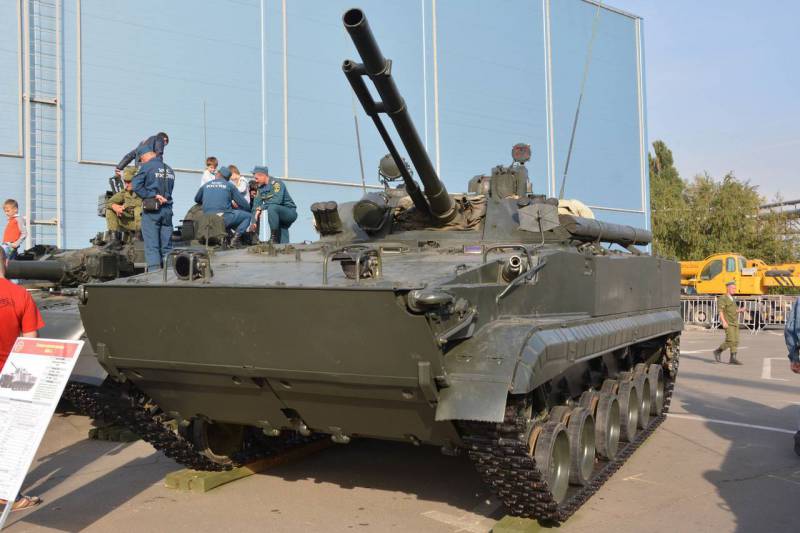The project of the unmanned combat vehicle "Strike"
For the first time about the existence of a new car became known in early October last year. An interesting sample of an unusual type was filmed by photographers during the preparations for the exhibition “Innovation Day of the Ministry of Defense”. A few days later, already during the exhibition itself, the developers and the military revealed some information about a promising project. In particular, it was announced that the prospective model, which received the symbol “Strike”, uses remote control systems, due to which it does not need the presence of the crew on board.
The development of the project is carried out by experts of the All-Russian Scientific Research Institute "Signal" (Kovrov). Representatives of the developer organization mentioned that the main goal of the project is to create a unified system consisting of control and armament equipment that can be mounted on various basic platforms. Such features of the project should ensure its further development, which in the future may lead to the emergence of new similar models of equipment.
The new project "Strike", as follows from the available data, is an experimental attempt to develop a promising combat vehicle based on existing components. The tracked undercarriage of the infantry fighting vehicle BMP-3 was chosen as the basis for the “Strike”. The armaments of the advanced model are mounted on the Boomerang-BM combat module, borrowed from another recent project. In addition, in the framework of the project "Impact" a number of completely new equipment was developed. First of all, these are control systems that use a radio channel for two-way communication of the operator’s console and a combat vehicle.
In addition to creating some new systems, the authors of the Udar project had to refine the existing components and assemblies in order to ensure the required compatibility. In particular, some modifications had to expose the armored body of the base chassis. Also, by changing and improving the existing structure, the problem of installing automated control systems, including those using a radio channel, was solved.
According to the available data, the serial chassis of the infantry fighting vehicle BMP-3 was taken as the basis for the experimental model "Strike". Such equipment has been built and operated by the army for a long time, and also has rather high technical and operational characteristics. During the construction of the prototype "Stroke" the base chassis underwent some modifications. For example, to install the required combat module, we had to change the roof structure of the existing hull: a small tower of low height appeared on it, having the shape of a truncated pyramid. The need for such a superstructure is due to the design features of the combat module, namely, the dimensions of the parts located below the shoulder straps. In addition, the design of the frontal part of the hull was changed. In view of the removal of the crew, the machine lost its course machine-gun installations, which led to the expansion of the front hull sheet and another variant of its connection with the sides.
The remaining units of the base chassis, apparently, remain without significant changes. Thus, the corps is preserved with protection from small-caliber artillery in frontal projection and with anti-bullet armor for other units. The layout of the case should also remain without significant changes. In front of the hull there is a department of management in which a part of the new equipment is placed, and also the workplaces of some crew members are saved. The fighting compartment remains in the center of the vehicle, and a compartment is placed in the stern to accommodate the power unit.
In its basic configuration, the BMP-3 is equipped with a UTD-29 diesel engine with an HP 500 power. With the help of such a power plant, the 18,7 t combat vehicle can accelerate to 70 km / h on the highway. With the help of jet propulsion, movement through water is ensured at speeds up to 10 km / h. A tracked undercarriage is used, having six road wheels each with an individual torsion suspension and additional hydropneumatic shock absorbers on each side. It is possible to adjust the tension of the tracks from the driver’s control station.
In the framework of the new project, a small modernization of the armor corps was proposed, consisting in the use of a special superstructure on the roof. On this superstructure, with some excess over the original case, there is a shoulder strap for installing the tower. Apparently, the use of the superstructure is associated with the specific layout of the selected combat module, which requires some space below the shoulder strap.
The Boomerang-BM combat module, equipped with a variety of different barrel and rocket weapons, is installed on the superstructure of the Udar machine. On the rotary platform of the combat module, the required armament and optoelectronic equipment is mounted for target search or guidance. weapons. An important feature of the system "Boomerang-BM" is the use of remote control. All operations are carried out by automatic commands from the remote operator-gunner. In the case of the project "Shock", the remote can be moved outside the combat vehicle.
The 2А42 automatic caliber 30 mm is placed in the central part of the combat module. To her left on the common mounts is placed 7,62-mm machine gun PKTM. Ammunition barrel systems consists of 500 shells for cannon and 2000 cartridges for machine guns. On the sides of the tower are placed two launchers with mounts for two transport and launch containers of missiles each. The Boomerang-BM module uses the Kornet anti-tank guided missiles. Also on the outer surface of the combat module there is a set of smoke grenade launchers.
The module is equipped with two blocks of opto-electronic equipment to be used by the gunner and the commander of the combat vehicle. Gunner equipment is located to the right of the barrel weapons, on the same level with him. The commander’s sight, in turn, is placed on the roof and can be rotated around its axis. Optical-electronic equipment "Boomeranga-BM" provides a search for targets in the optical and infrared bands, which allows the use of the combat module at any time of day and in various weather conditions. The fire control system has the ability to automatically track targets, is capable of firing at external target designation, as well as fire at two targets simultaneously.
The main innovation of the project "Strike" is the original control system that provides a solution to several basic tasks. According to reports, the chassis and combat module retain the ability to control the forces of the crew. If necessary, for example on the march, the combat vehicle can be controlled by the crew. In this case, the driver is responsible for the movement, and the commander and the gunner can monitor the situation and engage in self-defense. When solving combat missions in certain conditions, the crew gets the opportunity to leave their car and use remote controls to control it. The control panels over the radio channel support two-way communication with the equipment of the machine and provide a solution to the problems posed when using several modes.

The combat module "Boomerang-BM" and the body superstructure for its installation. Photo Sdelanounas.ru
The crew has the opportunity to drive the car, being outside. In this case, the on-board automatics receives control commands, and also transmits to the console a signal from several video cameras installed along the perimeter of the armored case. In addition, data is transmitted on the operation of certain systems. Focusing on the image from the video cameras, the driver gets the opportunity to control the movement of the car. The situation is similar with the equipment for controlling the combat module. With the help of two-way communication, the gunner operator can receive data from the Boomerang-BM system, as well as transfer necessary commands to it.
Also developed a fully autonomous mode. In this case, the automatic machine “Strike”, having received the task, begins to move independently. Before reaching a given point, the machine does not transmit or receive any signals, which facilitates its secretive use. Arriving in the specified area, the armored vehicle can reconnect with the operator to conduct reconnaissance or destroy the detected targets.
A special case of the use of fully automatic control may be the use of the platform "Impact" for transport purposes. A mode is proposed in which the combat vehicle will be able to pass a certain route according to the driver’s commands, memorizing it. Then the control automation will be able to independently go along this route without needing the help of a person. It is assumed that such a regime will find application in routine work, for example, with the repeated transport of goods or personnel along the same route.
According to some sources, when operating in the manned mode, the strike machine uses the standard controls of the BMP-3 and the Boomerang-BM module. The crew is located in the department of management. Remote control is proposed to implement using a set of consoles and other equipment. In the case of the showpiece shown last year, the operator’s workplaces were mounted on a standard army vehicle. Some of the necessary equipment was installed inside the body, and a number of units - on the roof. During the “Impact” shows, the management machine was located not far from it and controlled all the actions.
Available information about the project "Strike" suggests that in the future it may lead to the modernization of a certain number of BMP-3 in the army using new equipment that enhances the characteristics of the combat vehicle. However, some features of the prototype shown may contradict this assumption. In particular, in discussions of the experimental machine, it was repeatedly pointed out the specific refinement of the hull. Installing a new turret box and combat module of the required model leads to a significant increase in the size of the machine. Also during modernization, the weight of the whole structure should increase significantly.

Aft part of the combat module and hull. Photo Gurkhan.blogspot.ru
After such alteration, some deterioration in mobility characteristics should be expected. In particular, serious problems may appear with overcoming water barriers by swimming. An increase in mass may impair buoyancy, and large aggregates placed above the hull can seriously damage stability. As a result, the existing sample in some parameters may be ahead of the existing BMP-3, but in others it may lag behind it.
Such features of the project can be explained by its experimental nature. Earlier, representatives of the All-Russian Scientific-Research Institute “Signal” stated that the purpose of the “Strike” project is to create a unified system that combines a combat module and remote control means with several modes of operation, including an automated one. After the successful completion of such work, the military department may be offered a new version of the modernization of various armored vehicles with an increase in the basic characteristics and the emergence of new capabilities.
In the future, the new equipment created in the framework of the project "Kick" can be used in the modernization of other combat vehicles. For example, we can expect the installation of such equipment on new platforms that are currently being developed. Thus, one should not exclude the possibility of creating unmanned vehicles of the families “Kurganets-25”, “Boomerang”, etc. Such equipment will have some advantages over basic models that will provide the solution of some combat missions in difficult conditions.
The first demonstration of a promising combat vehicle with the ability to work without a crew took place in October last year. At present, the prototype "Blow", apparently, is undergoing various tests, is being finalized and improved. Probably, at the new events dedicated to the development of domestic weapons and equipment, the development organization and the Ministry of Defense will again show an interesting and promising sample. What will be the future of the prototype and how the development of the project will be completed is not yet completely clear. It should be expected that in the near future industry and the military will reveal their plans for a new development.
On the materials of the sites:
http://vestnik-rm.ru/
http://utro.ru/
http://bastion-karpenko.ru/
http://gurkhan.blogspot.ru/
http://bmpd.livejournal.com/


Information